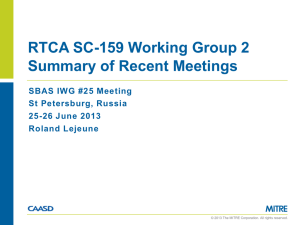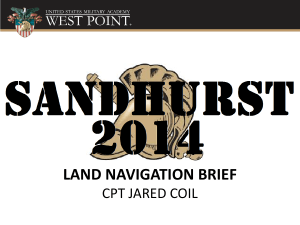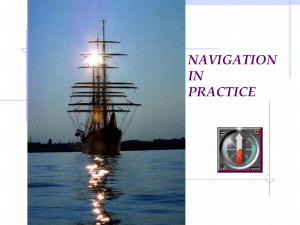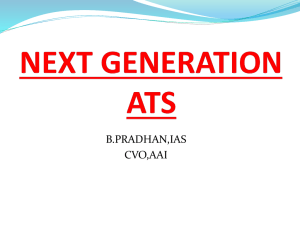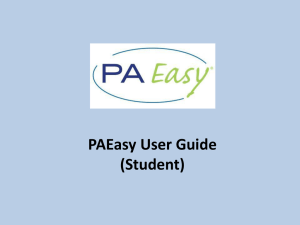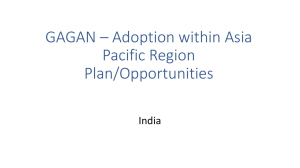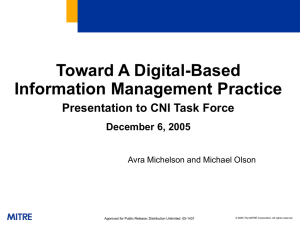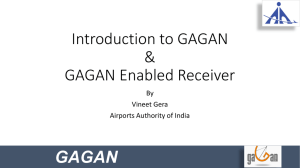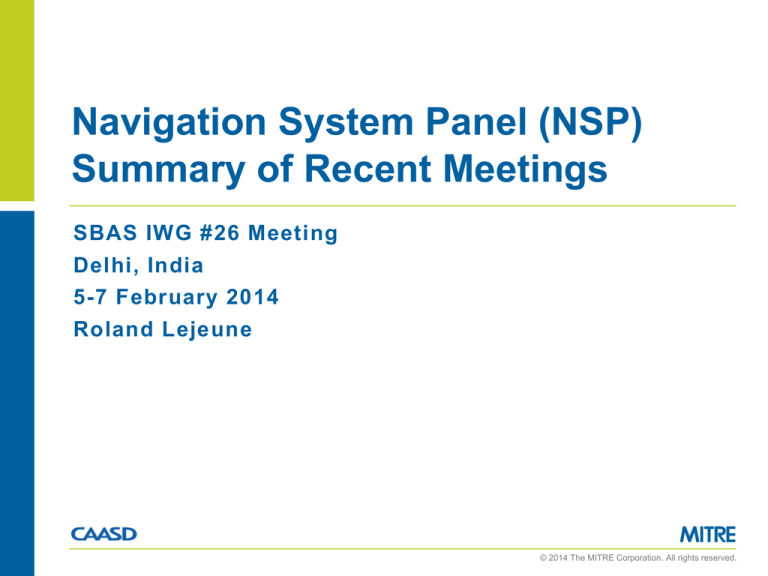
Navigation System Panel (NSP)
Summary of Recent Meetings
SBAS IWG #26 Meeting
Delhi, India
5-7 February 2014
Roland Lejeune
© 2014 The MITRE Corporation. All rights reserved.
|2|
Introduction
One NSP meeting took place since IWG/25:
– November 12-21, 2013
Agenda items
– Panel organization and work program
– Core constellations and SBAS standards and guidance material
– GBAS standards and guidance material
– Conventional Navigation Aid standards and guidance material
– Spectrum issues
– Operational implementation issues
This briefing reports mainly on SBAS-related discussion
– However, some information is provided on a few other topics
© 2014 The MITRE Corporation. All rights reserved.
|3|
Panel Organization
Air Navigation Commission (ANC) is working on a re-organization
of panels
– Request for consolidation of ICAO technical groups from 12th Air
Navigation Conference (Nov. 2012)
– Objectives: improved alignment between panels and work program,
and improved coordination among panels
– Decision expected to be made soon, but no deadline announced
Potential impact on Navigation Systems Panel (NSP)
– Spectrum area may be moved to a new Spectrum Panel in which all
spectrum related issues would be consolidated
– Performance Based Navigation (PBN) work may be moved to NSP
renamed simply Navigation Panel
Some open issues remained in PBN guidance material when the PBN
Study Group disbanded, and these issues are currently slowing PBN
implementation in some States
© 2014 The MITRE Corporation. All rights reserved.
|4|
Work Program (1 of 2)
ANC assigned 9 “Job Cards” to NSP
– Job Cards describe new work to be undertaken, including high-level
tasks and delivery schedules
Job Card concept is being instituted to facilitate ANC review of progress
Job Cards were not requested for existing work
– So, on-going tasks will continue (without Job Cards)
Maintenance of existing standards and guidance material (GNSS and
conventional radio navigation aids)
Standardization of Galileo and BeiDou core constellations
Maintenance of GNSS Manual (Doc. 9849) and Manual on Testing of
Radio Navigation Aids (Doc. 8071)
– All 5 Job Cards prepared by NSP during March 2013 meeting, plus
one prepared by the Secretariat, were assigned to NSP, but the
“GNSS evolution” Job Card was split into 4 separate Job Cards
See next page
© 2014 The MITRE Corporation. All rights reserved.
|5|
Work Program (2 of 2)
Job Cards assigned to NSP
1.
2.
3.
4.
5.
6.
7.
8.
9.
Maintenance of Navigation Roadmap
GNSS Evolution - Multi-constellations
GNSS Evolution – SBAS
GNSS Evolution – Advanced Receiver Autonomous Integrity
Monitoring (ARAIM)
GNSS Evolution – GBAS
GNSS Radio Frequency Interference
Mitigation of Space Weather Effects
Rationalization of terrestrial navigation aids
Alternative Position Navigation and Timing (APNT)
© 2014 The MITRE Corporation. All rights reserved.
|6|
Core constellation standards
GLONASS
– GLONASS status and observed performance
– Update to the coordinate system (PZ-90)
– Approval of a SARPs change on resistance to interference
Corresponding to a similar change in GPS/SBAS SARPs
BeiDou
– BeiDou status
– Initial draft SARPs material for B1I signal (1561 MHz)
Further information on use of BeiDou signals requested in order to
determine whether B1I needs standards for international aviation
Galileo
– Galileo status
– Initial draft SARPs material for E1 and E5a signals
© 2014 The MITRE Corporation. All rights reserved.
|7|
SBAS standards (1 of 2)
Proposed changes to SBAS SARPs for consistency with SBAS
user receiver MOPS, DO229D, Change 1
– Approval of change package containing 24 changes to reconcile
requirements in SARPs with those in avionics MOPS
Change should be reflected in Amendment 90 applicable in Nov. 2015
Proposed change to Table 3.7.2.4-1 on signal-in-space
performance
– Approval in principle on two proposed new notes to (1) declare
APV-II non-applicable to SBAS and (2) clarify that SBAS can be
used for LNAV/VNAV operations
Exact wording still to be agreed
Approval in principle will be used for coordination with Instrument Flight
Procedure Panel (IFPP) which had commented on difficulties created by
APV-II and lack of LNAV/VNAV lines in Table 3.7.2.4-1 for their work
– IFPP is responsible for developing PANS OPS (Doc. 8168)
© 2014 The MITRE Corporation. All rights reserved.
|8|
SBAS standards (2 of 2)
RTCA SC-159 WG2 report
– Decision to start gathering data on dual-frequency, multiconstellation SBAS signal-in-space and concept of operation
RTCA/EUROCAE “score card”
– On-going effort to document information needed from core
constellation providers to support the development of avionics
MOPS, and the information that is available
Expect completion for GPS and Galileo by end of 2013
Requested help from Russian and Chinese colleagues for GLONASS
and BeiDou to complete the score card
IWG progress
– Analysis of two options for message structure is expected to
converge to a consolidated structure in Spring of 2015
© 2014 The MITRE Corporation. All rights reserved.
|9|
Multi-constellation GNSS (1 of 2)
Service provision in the multi-constellation context
– Observations on provision of air navigation services (as per Chicago
Convention) and provision of core constellation services
Need for some form of augmentation (e.g., RAIM) to achieve integrity
requirements
Need for cooperation between core constellation service provider (CCSP)
and air navigation service provider (ANSP) of the same State to support
safety case and approvals
– Requires failure modes and effects data, details of which are often not
made publicly available
Basis for other ANSPs to approve the use of the services
– Requires commitment from CCSP to ICAO to meet certain standards
Examples: for GPS Annex 10 refers to standard positioning service
performance standard and has major service failure standard
– Author suggests that more detailed information on failure modes and
probabilities may be needed for approvals in multi-constellation context
© 2014 The MITRE Corporation. All rights reserved.
| 10 |
Multi-constellation GNSS (2 of 2)
Observations regarding the development of multi-constellation
systems
– Air navigation service providers are responsible for approvals
This implies that ANSP assumes responsibility for safety
Performs some data recording for potential incident investigations
Is satisfied that approved core constellation meets the standards
– The latter point can be based on thrust into the processes of ANSP of
State of CCSP (e.g., approvals by FAA of navigation based on
GPS/RAIM) and/or active data recording and analysis
– Panel agreed to develop further guidance on related issues
Objectives of data recording and monitoring, methodology, policy for
retention of data, reporting and notification in the case of observed
anomalies
© 2014 The MITRE Corporation. All rights reserved.
| 11 |
Advanced RAIM
To what extent should ARAIM be standardized?
– Additional performance requirements (beyond those already in
Annex 10)?
– Link(s) to transmit the Integrity Service Message (ISM)?
– Elements of the algorithm?
Update on progress in related research and development
– To be provided at the next meeting (May 2014)
Input to standardization work
– To be provided at the following meeting (October 2014)
© 2014 The MITRE Corporation. All rights reserved.
| 12 |
Other Areas of Work (1 of 2)
GBAS
– Conclusion that standardization of Terminal Area Procedures (TAP)
was premature at this time
– VHF Data Broadcast (VDB) link budget continues to present
difficulties; industry to consider raising height above runway
surface to 45 ft for minimum signal level
– Validation of GBAS Approach Service Type D (GAST-D) is
progressing and finalization of SARPs material is expected in 2nd
quarter of 2015
Spectrum
– Panel agreed to develop guidance material on reporting of
international interference incidents based on earlier ICAO bulletin
and material from a EUROCONTROL workshop
© 2014 The MITRE Corporation. All rights reserved.
| 13 |
Other Areas of Work (2 of 2)
Conventional Navigation Aids
– Several papers on rationalization (decommissioning) of VHF OmniDirectional Range (VOR) will be used as input to development of
ICAO guidance
– Potential way forward on updating the guidance material on
Instrument Landing System (ILS) Critical and Sensitive Areas by
raising minimum level for localizer signal protection from 200 to
400 feet
Further work on glide slope protection still needed
Interference from repeater stations
– Results of German study on position errors from airborne receiver
affected by repeater signals exceeding power limits
Suggests further robustness and/or ability to detect and alert be built in
future receivers
Issue to be brought to attention of RTCA and EUROCAE
© 2014 The MITRE Corporation. All rights reserved.
| 14 |
Acronyms
ANSP
Air Navigation Service Provider
APNT
Alternative Position Navigation and Timing
APV
Approach with Vertical Guidance
ARAIM
Advanced Receiver Autonomous Integrity Monitoring
GBAS
Ground-Based Augmentation System
DFMC
Dual-Frequency, Multi-Constellation
GNSS
Global Navigation Satellite System
ILS
Instrument Landing System
IWG
Interoperability Working Group
LNAV/VNAV
Lateral Navigation/Vertical Navigation
MOPS Minimum Operational Performance Standard
NSP
Navigation Systems Panel
PBN
Performance-Based Navigation
SARPs
Standards and Recommended Practices
SBAS
Satellite-Based Augmentation System
VOR
VHF Omni-directional Range
© 2014 The MITRE Corporation. All rights reserved.




